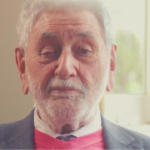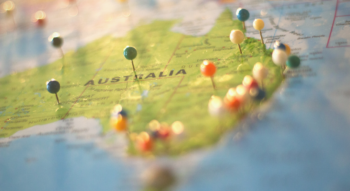Episode Notes
The upcoming Voice Referendum presents a pivotal moment for Australia to reshape its relationship with Aboriginal and Torres Strait Islander people and confront the truths of our history. Join us for this captivating episode with the esteemed The Hon. Dr Barry Jones AC, former politician and noted polymath. With his wealth of experience and wisdom, Dr Jones fearlessly explores the attitudes of the past and challenges us to ask ourselves a crucial question: Is it finally time to embrace honesty and ignite a change that propels us toward unlocking our nation’s full human potential?
Don’t miss this captivating speech that will compel you to reflect, question, and envision a future where recognition and acceptance pave the way for a more inclusive and compassionate Australia. Tune in and join us on this remarkable journey of truth, change, and the pursuit of our collective destiny.
Transcript
I’m Barry Jones and I want to talk about the changing way in which we think of ourselves as being Australian, and it begins 65, 000 BCE.
Homo sapiens first arrived in Australia about 65,000 years ‘before the common era’, or BCE. We cannot pin down a specific date for their arrival. The abbreviations AD or BC of the Christian calendar have no significance in China, India, Indonesia and Japan, but using the concept of the ‘common era’, or CE, means that they use the same numbers for years as Europe, the Americas and Oceania.
In the period sixty-five to sixty-seven thousand years ago, Australia had a land bridge with New Guinea, but not with Asia – as the separate development of our unique fauna and flora demonstrates. So our first inhabitants would have arrived from Asia and from New Guinea by sea.
Over sixty-five millennia a complex society evolved with its own art, mythology, up to five hundred languages and dialects, funeral practices, making tools and weapons, navigation, trading goods and materials across the continent, medicine, diet, the management and commitment to the land or ‘country’. Some ‘nations’ or tribes were nomadic, essentially hunter-gatherers, others managed their own estates with fixed boundaries. Some have stone buildings and complex eel traps.
The claim that our First Nations people have the longest continuous history on the planet is soundly based.
We have no written records but the surviving rock and cave art is eloquent and powerful.
There were contacts with Macassans, Dutch, Spanish, English, French and probably Chinese and Portuguese.
Then, 1788 CE.
26th January 1788 was a very important day in Sydney but it may not have been particularly noteworthy in the site that became Melbourne. Sydney first commemorated the day in 1838, fifty years on. Each state had its own celebratory day – in Victoria it was Empire Day from 1905 until 1958.
Colonisation is always violent.
The two major elements in British settlement of Australia after 1788 were the convict system and the dispossession of Indigenes, killings and the systematic destruction of their culture. This contributed to an authoritarian strain in the Australian system, which remains, although there was a more liberal, open, democratic, sometimes larrikin, national narrative as well.
In 1788 the Indigenous population has been estimated as between three hundred thousand and above a million, with seven hundred and fifty thousand being probably the best estimate, most living in the southeast of the continent: similar to contemporary distribution of population generally.
The introduction of disease, especially smallpox, as early as 1789, decimated Indigenous communities. There were two hundred massacres that we have some details about in what has been called ‘the Frontier Wars’, a hotly contested issue in ‘the culture wars’. There may have been about four hundred. Professor Lyndall Ryan has estimated sixty-five thousand Indigenous killings in Queensland alone, between 1788 and 1930, with many thousands in other colonies/ states.
It is possible that Indigenous killings number as many as Australian deaths in action in World Wars I and II combined.
Indigenous Australians were driven off their traditional lands, forbidden to speak Indigenous languages, many children removed from their mothers – ‘the Stolen Generation’- until about 1970, and often tormented, starved, shot or poisoned. The last officially sanctioned massacre occurred in 1928 in the Northern Territory, near Coniston Station. There were ‘unofficial’ massacres in the 1930s.
There was never any attempt to negotiate treaties with First Nations peoples, unlike Canada, New Zealand and the United States.
In the 19th and much of the 20th Century what was called ‘the passing of the Aborigines’ was taken for granted. In recent decades authoritarianism was justified by the explanation, ‘we are doing it for their own good’, a rigidity, harshness, cruelty, even sadism in institutions – armed forces, churches, schools, and orphanages.
Our failure to recognise the suffering, dispossession and marginalisation of our First Nations was part of what the anthropologist W.E.H. Stanner, in his important Boyer Lectures in 1968 for the ABC, called ‘The Great Australian Silence.’
Being honest with ourselves…
‘Australian history does not read like history but like the most beautiful lies,’ Mark Twain wrote in his book, Following the Equator.
A number of important elements in Australia are marked by a striking lack of candour – a hesitancy about grasping the truth.
Australia’s way of dealing with racism was to deny that it existed, relying on evasion and amnesia.
Mark Twain, the most famous American author of his time, whose Tom Sawyer and Huckleberry Finn were international best settlers, visited Australia in 1895 and saw things that nobody around seemed to notice, and certainly did not want to discuss. He wrote powerfully about the killing of Indigenous Australians, ‘the bush pudding with arsenic revenge’: ‘They did not kill all the blacks, but they promptly killed enough of them to make their persons safe. From the dawn of civilization down to this day the white man has always used this very precaution.’
Mark Twain was amazed that when he raised these issues, the reaction was not outrage but indifference.
White Australia was one of the driving forces of the Federation movement, and Alfred Deakin, a liberal reformer on most issues, was a zealot on race. And the White Australia Policy remained in force until the 1970s.
When the Commonwealth of Australia was inaugurated in January 1901, the Premier of New South Wales, William Lyne, observed: ‘Of the three great colonial possessions, Australia’s lot has been the happiest. Unlike Canada and South Africa, she has not had a race problem to solve.’
The strongest intellectual influence on me as a child was Hendrik Willem van Loon, an American journalist and historian, born in The Netherlands, whose “The Story of Mankind” and “The Home of Mankind” shaped my thinking. He had the cartoonist’s gift for explaining complex subjects with powerful images. “The Home of Mankind” was a world geographer. He deplored the ‘incurable vice of nationalism’ and the horrors of what he called ‘the Great Era of Exploitation’, during the Imperial expansion of the 19th century. Then came three sentences, which horrified me, when I read them first, at the age of six or seven:
‘The man-hunts with horses and dogs organized to exterminate the aborigines of Australia are rarely mentioned in the histories devoted to the early years of that distant continent.
‘Why go on? wrote Van Loon, ‘I am merely repeating what everybody knows.’
Hendrik van Loon, “The Home of Mankind”, is writing that in 1933.
I didn’t know about it, nor did my teachers. Nor did textbooks record it.
Significantly, although I read few books by Australians or about Australia at that time, I remember that in promotional material for the Sesquicentenary of European settlement in 1938, Indigenous Australians had been included in a list of fauna. That did seem odd.
There was a strong white supremacist theme in initial enthusiasm for participation in World War I expressed by C.E.W. Bean, later the pre-eminent war historian: that Australia was the only continent without racial mixture. A bit of a stretch there, but he saw Indigenes as marginal, irrelevant or headed for extinction.
Australia Day or Invasion Day.
The Sesquicentenary in 1938 was commemorated nation-wide on 26th of January but it retained a New South Wales emphasis until the Bicentennial in 1988.
Australia Day was only observed in every state and territory from 1994, a late date which will come as a surprise.
There was always a degree of confusion about what had happened on the original 26th of January – some, including at least one former Prime Minister – thought it was James Cook’s landing at Botany Bay rather than the arrival of the First Fleet under Arthur Phillip.
The satirical blog “The Shovel” reported on a poll asking Australians the significance of 26th of January and the answers included: ‘Captain Cook landed on Gallipoli as part of the Eureka War’ and ‘The Southern Cross star constellation first formed’– that’s brutal, but close to the bone.
Now we’re in 2023.
Given its unpromising beginnings in 1788, ‘settler Australia’ is and has been a country of remarkable achievement, outstandingly successful in many areas. But we could achieve far more for ourselves and humanity generally if we came clean about our past.
We have much to be proud of. There are about one hundred and eighty nations on earth and Australia ranks in the top ten on many social indicators: democratic practice and free elections, the human development index, life expectancy (although we slipped a little under Covid), high literacy rates, excellent research and institutions, possibly the most successful multi-cultural nation, and a spirit of optimism. The traditions of ‘mateship’ and ‘the fair go’ are still robust. We have been outstanding in how we deal with emergencies – bushfires, floods, accidents on roads, in rivers and oceans, the air. Sport has had an important levelling effect in Australian society.
Of course, there are problems too – number one in the world for gambling, troubling levels of obesity and alcohol dependence, Indigenous incarceration rates and deaths in custody, some of the most segmented schooling in the OECD, some brutal agricultural practices in treatment of land, forests and waterways, failure to produce economically complex products.
The 2021 Australian Census recorded an Indigenous population of eight hundred and twelve thousand. Aboriginal and Torres Strait Islanders number 3.3% of Australia’s population, 28% of all prisoners, 13% of homicide victims and 11% of those charged with homicide. Adult prisoners as a proportion of all incarcerations range from 9% in Victoria – 691 prisoners – to 84% – 1,477 – in the Northern Territory.
‘Blinding trachoma’ ended in Europe and the United States in the 1950s but remains in some remote Australian Indigenous communities, and I have had some involvement in the campaign to end it. Indigenous issues remain highly sensitive with much of the Coalition’s base, demonstrated by a failure to endorse the ‘Uluru Statement from the Heart’ in May 2017.
What about alternative days for commemoration?
The 1st of January? Anniversary of the establishment of the Commonwealth of Australia in 1901. Of course, it’s already a public holiday.
26th of January. Could be renamed ‘First Fleet Day’ or ‘White Australia Day’. Age is the most significant area of difference of opinion on this. Polling indicates that Australians under thirty-five overwhelmingly support changing if and how we commemorate 26th of January – perhaps as ‘Invasion Day’ or ‘Survival Day’. Those over fifty strongly support the status quo.
What about the 3rd of March? That’s the date the Australia Act of 1986 came into force, ‘repatriating’ the Commonwealth Constitution with the United Kingdom Parliament graciously giving up its power to legislate for us. But the Constitution itself remains cringe-making.
Then there’s the 27th of May. That’s the date of the 1967 Referendum which allowed Aboriginal and Torres Strait Islander people to be counted in the Census and the Commonwealth Parliament to be able to make laws about them.
The Referendum on ‘A Voice to Parliament’
Peter Dutton has explained his reluctance to support the Referendum on inserting ‘A Voice to Parliament’ in the Constitution is that far more detail must be provided because that the proposed ‘Voice’ might cripple how Government works. The charges are wrong, hypocritical and dishonest.
In Australian Referenda, the question posed is almost always very simple, sometimes even obscure, leaving detail to be worked out by the Parliament in legislation if it is passed. The questions expand the role of Parliament – they never contract it.
In 1946 a Referendum was carried giving Parliament the capacity to make laws on social services. The question asked was:
Do you approve of the proposed law for the alteration of the Constitution entitled ‘Constitution Alteration (Social Services) 1946’?
Note that there was no detail provided: not one word referring to maternity allowances, widows’ pensions, child endowment, unemployment, pharmaceutical, sickness and hospital benefits, medical and dental services.
In 1999 a Referendum to insert a Preamble in the Constitution, put up by the Howard Government, asked the question, which reads, in all its glory:
‘A PROPOSED LAW: to alter the Constitution to insert a preamble.
DO YOU APPROVE THIS PROPOSED ALTERATION?
It could hardly be described as packed with detail. What on earth was the proposed Preamble? True, the Referendum failed, and may even have been intended to fail.
The proposed Preamble begins ‘With hope in God’ and advances eight ‘feel good’ propositions of which No. 4 reads:
“honouring Aboriginal and Torres Strait Islander people, the nation’s first people, for their deep kinship with their lands and for their ancient and continuing cultures which enrich the life of our country;”
The Aboriginal and Torres Strait Islander reference is just a wave from a gloved hand – virtually meaningless: ‘honour’, but no ‘action’.
But the Voice to Parliament, however constructed, has the potential to stimulate informed debate, set priorities and lead to practical outcomes.
Is it symbolic? You bet. Don’t underrate the significance of symbols.
But we must act now. Timing is, if not everything, always a central element in whether taking action will work.
I remember with some bitterness that in 1999, with the other Referendum, on a republic, there were zealots who said, ‘The model set out in the Referendum question doesn’t go far enough. If we vote it down now, a better model will quickly emerge so that we can all agree on it.’
Twenty-three years later, this has not yet happened.
I agree completely with Noel Pearson, Tom Calma, Linda Burney, the Dodson Brothers, Marcia Langton, Henry Reynolds, Gareth Evans, Judith Brett, Mark McKenna, Dean Ashenden; the time to act on ‘a Voice’ is now.
It is now 235 years after the 26th of January 1788, with ‘terra nullius’ as the law of the land for 205 of them. Our Commonwealth Constitution, dating from 1901, made only two references to our First Nations people – both negative: that they were not to be counted in the Census and the Commonwealth could make no laws for their benefit.
The 1967 Referendum was a valuable first step, the Mabo judgment of 1992 was a second, the ‘Apology to the Stolen Generation’ in 2008 a third – but we must now complete the journey.
This is not just for the benefit of First Nations people, it is an essential element of being honest with ourselves, to fulfil the human potential of all of us.
It’s time.
Do it now.



